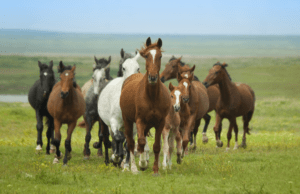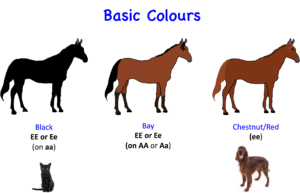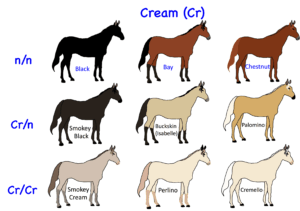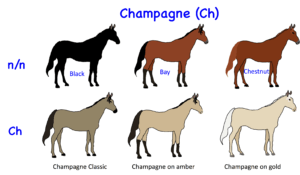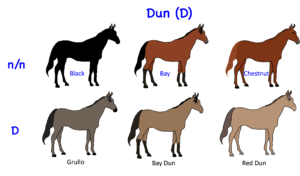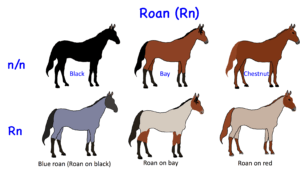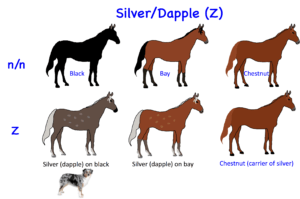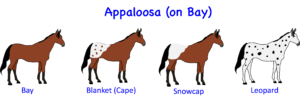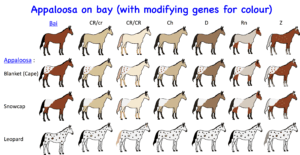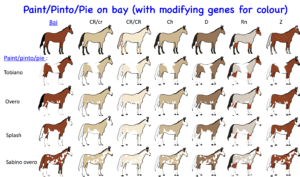Horse Genetics 2.0: Colours
Coat colours have been an important aspect of horse breeding. The genetics of coat colours in the horse can be discussed at three different levels:
- The genes that give the basic coat colour to the horse.
- Genes that modify the basic coat colours, usually by diluting them.
- Genes that result in coloured coat patterns, usually involving white spotting.
1. Genes for Basic Colours
As in other mammals, the melanocytes of the horse can produce two pigment colours, the black eumelanin and the yellow pheomelanin. These combine to produce the basic colours of the horse which include black, bay, and chestnut (also called sorel, red or alezan). The two genes responsible for these three basic colours are found at Locus E (Extension) and Locus A (Agouti).
Locus E is mostly concerned with the production of black pigment. When Locus E is mutated and non-functional (e/e), black pigment cannot be produced, yellow pigment predominates and a chestnut (red or alezan) horse is the result. It is the same recessive genetics in dogs that will give the Irish Setter its red coat colour.
Locus A (Agouti) is mostly concerned with the production of yellow pigment. When Locus A is mutated and non-functional (a/a), yellow pigment cannot be produced. This time, black pigment predominates and a black horse is the result. This is the same recessive genetics as seen in black cats, black rabbits and some (but not all) black dogs.
When both Locus A and Locus E are functional (i.e., A/-, E/-), both yellow pigment and black pigment can be produced. In this situation the horse is bay in coloration, with a brown body and dark (black) legs, main and tail.
2. Genes for Modification of the Basic Colours
The number of genes that can modify the basic colour in the horse is rather extensive compared to other domestic animals. These include Cream (Cr), Champagne (Ch), Dun (D), Roan (Rn), Silver/Dapple (Z) and Grey (G). Most of these genes have dominant genetics, and the general effect is to lighten or dilute the basic colour. It is interesting to note that the classic Locus D (Dilution) gene which is seen in dogs and cats (and rabbits) and that has recessive genetics is not seen in the horse.
Cream (Cr)
The Cream dilution gene, also called Cremello, has dominant genetics with incomplete penetration. This could also be called co-dominant genetics. What colour will result depends on the base colour of the horse and the number of copies of the Cr mutation. One copy of Cr will dilute a black horse to Smokey Black, while two copies will dilute a black horse to Smokey Cream. One copy of Cr will dilute a bay horse to Buckskin (also called Isabelle), while two copies will dilute a bay horse to Perlino. Finally, one copy of Cr will dilute a Chestnut horse to Palomino, while two copies will dilute a Chestnut horse to Cremello.
Champagne (Ch)
The Champagne dilution gene is a fairly rare gene that also displays dominant genetics. One or two copies of Ch will dilute a black horse to Classic Champagne, a Bay horse to Champagne on Ambre, and a Chestnut horse to Golden champagne.
Pearl (prl)
The Pearl gene is a recently described, rare gene that displays recessive genetics. Double mutant Pearl (prl/prl) will cause a chestnut colour to be diluted to Apricot. Double mutant Pearl will also interact with Cream (Cr) to give a pseudo-double cream coloration.
Dun (D)
The Dun gene displays dominant genetics. One or two copies of D will dilute a black horse to Grulla, a Bay horse to Dun on Bay, and a chestnut horse to Red Dun. Interestingly, the Dun gene is associated with what are called primitive bands involving dorsal and shoulder stripes of dark pigmentation and horizontal striping (barring) on the legs.
Roan (Rn)
The Roan gene displays dominant genetics. Individual white hairs are now distributed amongst hairs of the basic coat colour on the body of the horse, but not on the head, feet and tail. This has the affect of lightening the coat colour in the body of the horse: a black horse becomes Roan blue, a Bay horse becomes Roan on Bay, while a Chestnut horse becomes Roan on red. There is no progression in the degree of colour lightening with age for the Roan gene as there is for the Grey gene.
Silver (Dapple) (Z)
The Silver (Dapple) gene has dominant genetics that effects black pigments (i.e. black and bay horses), resulting in random patches of pigment dilution. Although the Silver (Dapple) mutation may be present in a Chestnut animal it is not readily evident. The Silver (Dapple) gene is the same gene that gives the phenotype Merle in the dog. As with the dog, double dapples are to be avoided as they can be associated with developmental problems of the eyes.
Grey (G)
The Grey phenotype involves a progressive dilution of hair colour. Foals are born with normal pigmentation but with age the colour of the hairs become silver (grey), white or “flea bitten”. The colour of the skin is not affected. The effect of the Grey gene in horses is similar to the greying of hair with age that is seen in humans. In horses the Grey gene displays dominant genetics, such that if a horse is Grey, then at least one of it’s parents was also grey.
3. Colour Pattern (White Spot) Genes
The horse has a number of genes that affect the pattern of pigmentation, mostly by introducing white spotting patterns. These patterns can be grouped into the Appaloosa patterns and the Pinto/Paint/Pie patterns of white spotting. These patterns can be transposed onto any of the three basic colours and on top of any one of the dilution modifying colours. While some of the genes responsible for these patterns have been identified, in general the genetics of white spotting in the horse is not well worked out. In addition (and as is seen in the dog and cat) there can be health concerns with some of the white spotting patterns in horses.
Appaloosa
Appaloosa refers to a striking pattern of white spotting often found on the hind end of the horse. The name comes from the horses of the Nez Perce people that lived by the Palouse River in the North Western United States. Appaloosa patterns include Appaloosa Blanket, Appaloosa Snowcap and Appaloosa Leopard. The gene mutation responsible for the Appaloosa Leopard pattern (Lp) has been identified and when found in two copies can be associated with eye problems (night blindness).
Pinto/Paint/Pie
Paint, pinto (Spanish for paint), piebald or pie patterns of white spotting in the horse are basically any white spotting pattern that is not Appaloosa. This type of white spotting is seen in a number of domesticated animals, and has been included in what is called the “domestication syndrome”. Piebald patterns are further classified as Tobiano or Overo type patterns, and Overo patterns are further subdivided into Overo Frame, Overo Splash and Overo Sabino. The genetics of these patterns is complicated and not well worked out.
Tobiano is a dominant form of Pinto patterning caused by a mutation in the Kit gene which is involved in neural crest cell migration. In the Tobiano pattern, there are smooth edges between white and pigmented areas. White areas tend to be vertical in orientation and can extend over the back of the animal. Health problems are not associated with the Tobiano coat pattern.
Overo Frame is a Pinto pattern where white regions are “framed” by coloured areas. Edges between white and pigmented areas can be jagged, and white areas tend to be horizontal in orientation. The face of the horse is usually white. The gene responsible for the Frame Overo pattern has been identified; it is the EDNRB gene which is involved with neural crest cell migration. The Frame Overo pattern shows incomplete dominance. When the mutation is homozygous (O/O), the foal will suffer from Lethal White Foal Syndrome. It is born completely white and dies in a couple of days due to an under developed intestinal nervous system.
Overo Splash is another Pinto pattern of white spotting. The pattern is believed to be polygenic in origin. Although mutations have not been identified, they may involve the MITF and PAX3 genes, both of which are important for neural crest cell migration and survival. Homozygote mutations may involve embryo lethality.
Overo Sabino is a Pinto pattern of abundant white spotting and white legs. A mutation in the Kit gene (called SB1) has been identified as one cause of the Sabino pattern although the pattern is believed to be polygenic. Fully expressed Sabinos may be completely white.
Dominant White (W)
Dominant White is a pigmentation pattern where the horse is white in coloration from birth. It is caused by another mutation in the Kit gene which shows incomplete dominance. Dominant white double mutants (W/W) are embryo lethal.
Colour Chart for Horse Colour Genetics (Simplified)
For a visual representation of colour genetics covered in this article, see the colour chart Horse Genetics 2.1: Colours Chart.


